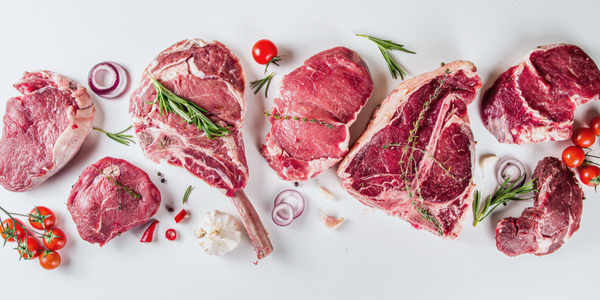
When it comes to diet "rules," red meat is often on the chopping block.
However, some eaters claim a meat-heavy diet—like the carnivore diet—is key to good health. All this to say, consumers are left with questions—and rightfully so.
So, is red meat actually bad for you? Join us as we reveal the truth and debunk other red meat misconceptions.
What Is Red Meat?
With so many meat products on the market today, it’s easy to be confused about red meat. Fortunately, we can differentiate red meat from white meat and other kinds based on color.
Meat is typically categorized as “white” or “red” based on a compound called myoglobin, a particular protein in muscle that binds to oxygen. Myoglobin determines the color of meat, and more myoglobin usually means the meat will be a rich red (or even purplish) color. For example, beef contains more myoglobin than chicken.
In more technical terms, red meat comes from the muscles of mammals. Popular picks in this category include:
• Beef
• Lamb
• Pork
• Veal
Unprocessed vs. Processed Red Meat
Red meat that hasn’t been processed can be stored in the fridge to preserve freshness (for a few days) or in the freezer (for a few months) until use at a later date. On the other hand, processed meat is preserved by methods that don’t include freezing, such as:
• Adding chemical preservatives
• Cooking at high temperatures
• Curing
• Heating
• Marinating
• Salting
• Smoking
While processing seems harmless, additional meat, animal fat, or even non-meat substances—like salt and preservatives—can be added. Ultimately, this can create a nutrient-poor product high in calories, fat, and sodium.
Common foods that fall in the category of being both red or processed meats include:
• Bacon
• Ham
• Hamburgers
• Hot Dogs
• Lunch meat
• Salami
• Sausage
Red Meat Nutrition
Red meat isn’t necessarily “unhealthy.” It offers many essential nutrients, most notably protein and iron.
Protein
Since protein promotes the growth and development of muscles, red meat may help individuals gain or maintain muscle mass.
Iron
Yet another essential nutrient that red meat contributes to the diet is iron. More specifically, red meat provides heme iron, a type of iron found in animal-based proteins. Heme iron is more easily and more completely absorbed than non-heme iron (the type that comes from plant foods).
Other Micronutrients
Another needed nutrient that red meat provides is vitamin B-12. This vitamin is essential to keeping red blood cells healthy and works alongside other B vitamins (which red meat also supplies) to produce energy from food.
Along with vitamins, red meat contains minerals such as selenium and zinc.
Quick Words On Red Meat Nutrition
While red meat does provide nutritional benefits, it’s not the only food you can get these nutrients from. This is excellent news for plant-forward consumers, including vegetarians and vegans.
The size, cut, and type of meat can also affect the overall nutritional profile of red meat, especially when it comes to fat and sodium content.
Benefits of Red Meat
Red meat was an essential part of ancestral eating patterns, thanks to the nutrients it provided. In modern times, red meat still provides many health benefits and can be part of a balanced diet.
Growth, Development & Maintenance
During certain life phases, red meat may be especially effective at fortifying the body. For example, post-menopausal women and elderly adults can incorporate protein-rich red meat into their diet in healthy ways to ward off age-related diseases like sarcopenia or osteoporosis.
Reasonable amounts of red meat are also often recommended during another unique life phase— pregnancy. Research suggests that eating red meat during pregnancy may help the body keep up with increasing iron demands while also working to maintain skeletal muscle and bone health.
Anemia Protection
Red meat can protect against anemia, a condition when the body has too few healthy blood cells. Since blood cells help deliver oxygen to tissues all over the body, this can create serious problems.
Fortunately, foods with enough iron and vitamin B12—like red meat—can lower the risks of anemia.
Health Concerns About Red Meat
While red meat’s health benefits are worth exploring, they are often overshadowed by the looming health risks of consuming too much red meat.
Although more evidence is needed, studies suggest a link between red meat and poor health outcomes. Processed red meats are particularly suspect, with no amount considered “safe.”
Heart Disease
Since red meat has higher levels of saturated fats (the “unhealthy” kind), the American Heart Association warns against consuming red meat too frequently since high amounts of saturated fat can cause cholesterol levels to rise. High cholesterol is a risk factor for more severe conditions, including heart attacks, stroke, and obesity.
Processed red meats are known to contain higher levels of sodium as well, which can contribute to high blood pressure and raise the risk of heart disease. In other words, eating red and processed meats more frequently is associated with a higher risk of heart disease.
Certain Cancers
Eating excessive amounts of red meat can also increase the risk for certain cancers, with research suggesting colorectal cancer in particular. Cooking red meats at a high temperature can also be an issue that increases risk since cancer-promoting chemicals (called carcinogens) can be created when temperatures get too high.
Processed meats can also contain carcinogens and, thereby, can increase the risk of cancer.
Other Concerns
Along with heart disease and cancer, eating too much red and processed meat has been linked with other health concerns. More research is to come, but current science suggests that red meat may be implicated in increasing the risk of dementia or diabetes.
Although there’s a lack of human studies available, a recent study on mice found that red meat may also negatively impact gut health and promote inflammation in the body. While much is still unknown, what is known is that dietary patterns high in red meat—especially processed meat—increase susceptibility to inflammation and inflammatory diseases.
The production of cattle raised for red meat is also not the most environmentally friendly. From cattle feed to processing plants, raising red meat creates many greenhouse gasses. Eating less red meat can be a way to contribute to a healthier environment, both for you and for the planet.
Is Red Meat Actually Bad for You?
Conflicted concerning the risks? The benefits you’re getting (or not getting) from red meat often depend on the type of meat you’re eating and the amount. Individuals with relatively low red meat intake seem to have a lower risk for related health risks, and lean meats or plant proteins are generally associated with an overall healthier lifestyle.
For individuals with risk factors for diseases like cancer or heart disease, it may be wise to minimize red meat intake instead of waiting to be diagnosed to make a change. Reducing your red meat intake can reduce your risk for certain health conditions
How Often Should You Eat Red Meat?
The age-old saying “moderation is key” seems to be true when it comes to red meat. For a healthy diet, variety and alternating red meat with other types of protein are recommended.
Does it sound too complicated? Swap red meat for seafood or lean meats (like chicken or turkey). Or, substitute whole grains, dairy products, or eggs for red or processed meat to help reduce overall health risks while still getting plenty of protein. Alternatively, eat plant-based proteins instead, such as legumes, soy, or nuts and seeds.
You can also try incorporating red meat as part of a healthy pattern, such as the Mediterranean diet. On this eating pattern, red meat is paired with fresh fruits and vegetables, whole grains, and healthy fats like olive oil.
General Red Meat Recommendations
The exact red meat “limits” continue to be debated, and you should ultimately discuss your unique needs with a dietitian, doctor, or another healthcare professional.
However, the general recommendation is limiting red meat to 3 servings per week, with more significant limits for those with heart disease, health risks, or high cholesterol. For reference, 1 serving is about 3 ounces or roughly the size of a deck of cards or your palm.
From Center Stage to Side Dish
One easy way to minimize red meat intake is to treat it as a treat! Enjoy it occasionally instead of as a diet staple. Make it a side dish instead of the main focus of the meal.
As mentioned above, eating processed meat should be an even rarer experience. It’s best to keep processed meats at a minimum since there’s no recommended amount.
Healthy Red Meat Intake Tips
Choosing healthy cooking methods and leaner cuts can instantly make your red meat a “healthier” choice. While these tips can help, keep in mind that monitoring serving size still matters and balancing meat with other foods is ultimately the best way to get all the nutrients you need.
Choose Healthy Cooking Methods
To keep red meat the healthiest it can be, think “try dry” when it comes to different methods of cooking meat. Dry cooking methods to keep meat from reaching too high a temperature include baking, roasting, grilling, and air frying.
Look for A Lean Cut
Mistakenly, many people believe that red meats can’t be lean meats. To the contrary, there are many cuts or types of red meat which can be lean, meaning they don’t have too much fat.
Look for the leanest cut—aim for at least 90% lean and no more than 10% fat—and know that sometimes this involves going to the meat counter and asking for a specific cut. If you don’t feel like chatting during your shopping trip, look for words like “lean,” “ground,” “round,” or “loin” on the package.
Can’t find a lean cut? You can also cut the visible fat strips off meat to make it leaner.
Meet a New Meat
Did you know that bison is a red meat? While it isn’t the most popular in modern times, bison was regularly utilized by Native Americans, so much so that it nearly became an endangered species. Luckily, bison are no longer endangered and provide another lean, red meat option.
Bison doesn’t contain nearly as much marbling (fat) as other types of animal muscle. This makes bison meat lower in cholesterol and calories while maintaining its status as a good source of vitamin B12 and iron. Plus, it’s said to have a more prosperous, sweet flavor than the familiar beef. In other words, branching out has its advantages!
Is Red Meat Actually Bad for You? Final Takeaways
So, what’s the verdict when it comes to red meat? While it provides essential nutrients during key life phases, it may cause more harm than good, particularly if ultra-processed and you have heightened health risks.
To preserve the health benefits of red meat and the nutrients it provides, prioritize high-quality and leaner cuts. Also alternate with other high-protein foods—like dairy, eggs, fish, and beans—and balance with fruits, veggies, whole grains, and healthy fats.







